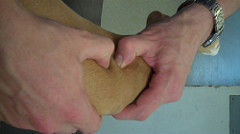The dreaded cruciate tear, something every dog owner fears. Well I’m here to tell you a bit more about this cruciate ligament tear, what options you have, and hopefully lighten the mood a little bit. There is no doubt about it, tearing any ligament is miserable for animals and humans, however, tearing a cruciate ligament seems to take the cake. The cruciates are located in the knee joint connecting the tibia and the femur. The main job of this ligament is stability, especially during pivots and turns, and it keeps these two bones from sliding across one another.
Why It Tears

A cruciate ligament will tear usually when there is a turning motion past the point of elasticity. This can happen with something as simple as slipping on the ice, falling in a mole hill, mis-stepping out of the car, or turning off the stairs incorrectly. When this ligament tears you will know almost right away. Your dog will likely run up to you with one leg hiked high in the air and/or limping depending on the severity of the tear. Most dog owners will wait a couple of hours, and when that leg doesn’t return to normal, quickly schedule a vet visit.
Upon visiting your veterinarian, they may do radiographs after examining the knee joint, but likely will tell you upon palpation if they think a tear is present. This can be detected by a gapping that will occur at the joint, something that shouldn’t happen with an in tact ligament. The only definitive way to diagnose a tear is via MRI or during surgery. Bringing us to our next point…what are your options when your pet tears this ligament? The majority of folks are told that surgery is the only choice and the only way to heal. You’ll likely also be told that after surgery to expect the other knee to have issues within a year or so. With such a bleak outlook, its no wonder the cruciate tear is one of the most dreaded diagnoses! 
Well let’s take a moment and talk about WHY a cruciate ligament would tear in an otherwise healthy animal, because really this is the question we should all be asking. If your pet were entirely healthy, with strong muscles, a thin physique, and an active lifestyle, why on earth would they have weak knees? It is not uncommon. Starting from a young age, these knee joints can begin to weaken unknown to fur parents across the nation. Each time your pet takes a spill, steps in a divot, twists incorrectly, and limps for a while, is an incident that will contribute to a weakened knee. Each microtrauma alone does not seem like much, however, when you have years of microtraumas added together, it can become one big macrotrauma instead.
Our pets are brilliant and will compensate for any minor (and sometimes major) injury so as to hide weakness. These weakened joints do not instantly strengthen; rather they alter their biomechanics to make it appear as so. When these joints are unstable they will stretch, push, and pull the cruciates to a point where they cause a great deal of wear and tear. Then one day when Fifi is outside in the backyard and she steps down in just the right direction, these ligaments will give and begin to tear. What you must understand is that these injuries are very rarely due to one major incident, but rather several incidents piled on top of one another. Just like that, your poor baby goes lame and your left with surgery as the only option.
Rehabilitation Options
No longer is that the case. When it comes to animal rehabilitation, options abound. For cruciate tears there absolutely is the ability for complete healing without surgery. We have several cases that opt to forego surgery (at least in the beginning) and instead go the alternative route. This route includes chiropractic (to stabilize the joints), acupuncture (to release pain and improve blood flow), hydrotherapy (to maintain muscle tone and strength), and supplementation (to support the joints internally). With the perfect storm of therapies, the majority of animals can recover from a cruciate tear without ever having to go under the knife. The nice thing about a cruciate tear is that you have options, and most of these options are not time sensitive, so you can easily try the alternative route initially and if it’s not helping your animal heal properly, then you can switch over to the conventional route.

What you don’t want to do is ignore a cruciate tear. A limp is always a sign of something else going on, and a constant limp is a sign that something needs to be addressed. Animals that show weakness, even for a few moments, are telling their fur owners that they may need to be checked out. When it comes to ligament tears, knowledge is power and we encourage everyone to ask questions so you can come to the right conclusion for your pet!
Photo Credit
injured reserve via photopin (license)

